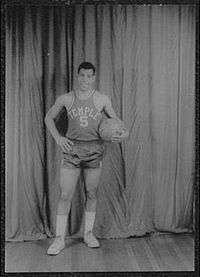Guy Rodgers
Guy William Rodgers (September 1, 1935 – February 19, 2001) was an American professional basketball player born in Philadelphia. He spent twelve years (1958–1970) in the NBA, and was one of the league's best playmakers in the early to mid-1960s. Rodgers led the NBA in assists twice, and placed second six times. Rodgers was inducted into Naismith Memorial Basketball Hall of Fame in 2014. [1]
 Rodgers in May 1958 | |
| Personal information | |
|---|---|
| Born | September 1, 1935 Philadelphia, Pennsylvania |
| Died | February 19, 2001 (aged 65) Los Angeles, California |
| Nationality | American |
| Listed height | 6 ft 0 in (1.83 m) |
| Listed weight | 185 lb (84 kg) |
| Career information | |
| High school | Northeast (Philadelphia, Pennsylvania) |
| College | Temple (1955–1958) |
| NBA draft | 1958 / Pick: Territorial |
| Selected by the Philadelphia Warriors | |
| Playing career | 1958–1970 |
| Position | Point guard |
| Number | 25, 5 |
| Career history | |
| 1958–1966 | Philadelphia / San Francisco Warriors |
| 1966–1967 | Chicago Bulls |
| 1967–1968 | Cincinnati Royals |
| 1968–1970 | Milwaukee Bucks |
| Career highlights and awards | |
| |
| Career statistics | |
| Points | 10,415 (11.7 ppg) |
| Rebounds | 3,791 (4.3 rpg) |
| Assists | 6,917 (7.8 apg) |
| Stats at Basketball-Reference.com | |
| Basketball Hall of Fame as player | |
Basketball career
Rodgers attended Northeast High School in Philadelphia, Pennsylvania, graduating in 1954. He played collegiately at Temple University from 1955–1958 for Hall of Fame Coach Harry Litwack.
Rodgers led Temple to a 74-16 record and third-place finishes in the 1956 NCAA Basketball Tournament, 1957 National Invitation Tournament and the 1958 NCAA Basketball Tournament. He became the school's leading career scorer with 1,767 points (19.6 points per game). Rodgers remains the third leading scorer in Temple history[2][3][4]
The 1958 AP First Team All-American team consisted of four Naismith Basketball Hall of Fame inductees: Guy Rodgers Temple, Elgin Baylor Seattle, Wilt Chamberlain Kansas and Oscar Robertson Cincinnati. The other was Don Hennon Pittsburgh.[5]
Rodgers was a territorial pick of the Philadelphia Warriors in the 1958 NBA draft.
Rodgers played alongside the great Wilt Chamberlain with the Warriors from 1959 through 1964. During Chamberlain's famous 100-point game, Rodgers had 20 assists.[6]
In the 1962–63 season, Rodgers led the NBA in assists with 10.4 per game, playing in his first NBA All-Star game. On March 14, 1963, Rodgers tied Bob Cousy's record of 28 assists in a single game — a record that wasn't broken until nearly 15 years later.[7]
Rodgers was the point guard on the 1964 Warriors team that made the NBA finals but eventually lost the series to the Boston Celtics four games to one.
After averaging 18.6 points and 10.7 assists in 1965-1966 Rogers was traded. On September 7, 1966, the Warriors traded Rodgers to the expansion Chicago Bulls for Jim King, Jeff Mullins and cash. Rodgers played the 1966–67 season in Chicago and was named an NBA All-Star for the fourth and final time in his career. That same season, Rodgers averaged 18.0 points and handed out a then-NBA record 908 assists (11.2), which is still the Chicago Bulls single-season record.[8]
With four games played in the 1967–68 season, Rodgers was traded to the Cincinnati Royals, joining Oscar Robertson in the backcourt. After the season in Cincinnati, Rodgers was selected by new Milwaukee Bucks in the expansion draft and joined the Bucks for his two final seasons, playing alongside rookie Kareem Abdul Jabbar.[8]
Personal life
Rodgers died on February 19, 2001 at age 65 after a heart attack. Rodgers was survived by sons, Tony and Mark, and daughter, Nicole.[3]
"Without question Guy Rodgers was the best passer I ever played with or against," said basketball TV analyst Jon McGlocklin, who was a teammate of Rodgers'. "Pete Maravich was close, but Guy was better. He made every play exciting."[9]
Honors
- Rodgers was a 2014 inductee to the Naismith Memorial Basketball Hall of Fame. During ceremonies on August 8, 2014. Earl Monroe served as Rodgers' presenter. His son Tony, accepted on behalf of the Rodgers family.[10]
- Rodgers is one of four Temple retired jersey numbers. His #5 hangs in the Liacouras Center. Teammate Hal Lear (#6), Mark Macon (#12) and Bill Mlkvy are the others. (#20).[11]
- Rogers was inducted into the Temple Athletic Hall of Fame in 1971.[4]
- Rodgers was a charter member of the Philadelphia Big Five Hall of Fame in 1973.[12]
- The Philadelphia Sports Hall of Fame inducted Rogers in 2005.[13]
See also
- List of National Basketball Association career assists leaders
- List of National Basketball Association players with most assists in a game
References
- "Guy Rodgers". Retrieved December 25, 2007.
- "Guy Rodgers College Stats". College Basketball at Sports-Reference.com.
- Williams, Lena (February 22, 2001). "Guy Rodgers, an N.B.A. All-Star, Dies at 65" – via NYTimes.com.
- "Guy Rodgers (1971) - Hall of Fame". Temple University Athletics.
- "NCAA College Basketball AP All-America Teams". Basketball-Reference.com.
- Heffernan, Jim (March 14, 1962). "Chamberlain makes the 'impossible' possible – 100 points". The Sporting News. Archived from the original on December 13, 2007.
- "NBA Regular Season Records: Most Assists – Single Game". Archived from the original on December 16, 2007. Retrieved December 25, 2007.
- "Guy Rodgers Stats". Basketball-Reference.com.
- "Guy Rodgers".
- "Five Direct-Elect Members Announced for the Class of 2014 by the Naismith Memorial Basketball Hall of Fame" (Press release). Naismith Memorial Basketball Hall of Fame. February 14, 2014. Archived from the original on April 12, 2013. Retrieved February 15, 2014.
- "Naismith Hall of Fame Welcomes Guy Rodgers". Temple University Athletics.
- "Philadelphia Big 5 - Hall of Fame". www.philadelphiabig5.org.
- "Philadelphia Sports Hall of Fame". www.phillyhall.org.